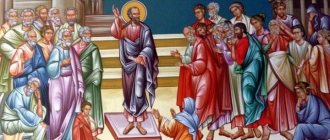Do you know the differences between the Julian and Gregorian calendars? Now we'll see.
Historically, Russia celebrates two New Years at once - the ordinary one, on the night from December 31 to January 1, and the Old New Year (or, to formulate correctly, the New Year according to the old style) - on the night from 13 to 14 January.
Few people think about why such a tradition arose, and even fewer people know when the so-called “new style” actually arose, how it differs from the “old” one, and why anyone needed to change it at all.
History of the Julian Calendar (Old Style)
Calendars were invented for calculating time and chronology. They existed among many peoples; calculations were based on astronomical observations of the periodicity of planetary motion.
The word “calendar” comes from the Latin word “calends,” which is what the Romans called the first day of each month. The months themselves consisted of 30 days, the year - of 10 months and 2 additional ones. From the 3rd century BC e. in the ancient world they used a variant based on the 44-year lunisolar cycle. It consisted of 365 days and 12 months.
This calendar was used in Rome during the reforms in 45 BC. e. and named after Gaius Julius Caesar, who initiated the reform. The beginning of the year was January 1, and this date is still used today.
In Russia, the Julian calendar was used until 1918, when it was replaced by the modern Gregorian calendar. They received the names of the old and new styles, respectively.
Sources
- Cheney, K.; Jones, Michael, ed. (2000). Date Guide for Students of British History
(PDF).
Royal Historical Society Guides and References. 4
(Revised ed.). Cambridge: Cambridge University Press. pp. 17–20. ISBN 978-0-521-77095-8. - Gerard, John (1908). "General chronology § Beginning of the year." In Herbermann, Charles (ed.). Catholic Encyclopedia
.
3
. New York: Robert Appleton Company.CS1 maint: ref=harv (communications) - "No. 9198." London newspaper
. September 1, 1752 p. 1. - Parliament of Ireland (1750). "The Calendar Law (New Style) 1750." Government of Ireland. Retrieved September 13, 2022.
- Philip, Alexander (1921). The Calendar: Its History, Structure and Improvement
. Cambridge: Cambridge University Press. paragraph 24. ISBN 9781107640214. - Russia: October (November) Revolution
(Internet ed.). Encyclopædia Britannica. 2007. Retrieved March 18, 2007. - Steele, Duncan (2000). Marking Time: An Epic Attempt to Invent the Perfect Calendar
. New York: John Wiley and Sons. ISBN 9780471404217. - Bond, John James (1875), A Handbook of Rules and Tables
, London: George Bell and Sons, pp.xvii–xviii - Poole, Robert (1995). "'Give us our eleven days!' ": Calendar reform in eighteenth-century England." Past present
.
Oxford Academic. 149
(1):95–139. Doi:10.1093/past/149.1.95. In the archive from the original dated December 5, 2014.
History of the Gregorian calendar (new style)
Julian has been used since its introduction for more than 16 centuries, but by that time there was a need to change it. The reason was the shift in the day of the vernal equinox. It was used to calculate the date of Easter, which was supposed to fall on the full moon.
As a result of many years of astronomical observations, it was found that in reality the length of the solar year is 365.2422 days, and not 366, as previously thought. That is, the tropical year is 11 minutes. 14 sec. shorter than the length of the year according to the old Julian calendar. Gradually, the discrepancy led to the fact that after 128 years one extra day was added to it. By the 16th century, the difference was already significant - as much as 10 days.
Expert opinion
Karnaukh Ekaterina Vladimirovna
Graduated from the National University of Shipbuilding, majoring in Enterprise Economics
Since 325, the equinox has shifted and fell on March 11, and not on the 21st, as in the astronomical year. There was a need to adjust the changes because the incorrect calculation of Easter Day will affect the incorrect calculation of the following period of Lent. And this is considered a great sin.
Pope Gregory XIII in 1582 proposed a new system to determine the exact date of Easter. It was required that it coincide with the full moon and must fall on Sunday. It was also necessary for the spring equinox to fall on March 21st again.
At first, the reform caused outrage and protests in scientific circles and among the people. But gradually most European countries, being Catholic, switched to a new style. Over the next centuries, it was adopted by Asian and Arab countries. In some countries this happened already in the 21st century. Some of the last countries to switch to the new style were countries such as Greece in 1923, Turkey in 1926, and Egypt in 1928. Already in 2016, Saudi Arabia was the last to join.
Expert opinion
Karnaukh Ekaterina Vladimirovna
Graduated from the National University of Shipbuilding, majoring in Enterprise Economics
The Gregorian calendar is not used in Ethiopia, Iran and Afghanistan, Nepal. These countries have their own forms of chronology. The modern calendar, and along with it the national calendar, is adopted in Israel, India, Bangladesh, Thailand, Taiwan, North Korea, and Japan.
What are the main differences
Calendars differ in that they have different numbers of leap years. In Julian, those that are divisible by 4 are considered to be such. In Gregorian, the same rule applies, but also those that are divisible by 100 are considered leap days if they are also divisible by 400. Thus, the difference between the calendars representing the old and new style is increases by 1 day every 100-200 years.
The difference between the same dates according to two calendars at the current time is 13 days and will increase by 3 days for each century.
An error of 1 day relative to the equinox will accumulate in Gregorian not as quickly as in Julian - approximately in 10 thousand years, while if they continued to use the old style, it would accumulate in 128 years.
Content
- 1 The beginning of the year in the historical records of Britain, its colonies and possessions
- 2 Adoption of the Gregorian calendar 2.1 Adoption in America
- 5.1 Other designations
What calendar is used in Russia
In the 16th century, countries subordinate to the Eastern Church did not accept the innovation, since it turned out that Easter in some years could come earlier than the Jewish one, which contradicted the canons of the church.
In Russia, the topic of the transition of the church to a new style has been repeatedly discussed. The transition was allowed only on the condition that the majority of Western Christians converted to Orthodoxy. But, in general, the reform was considered inappropriate. The last discussions regarding changes in the usual style took place in the 90s of the 19th century.
In Russia, the Julian calendar remained, which was adopted back at the time of baptism, in the 10th century. The New Year was celebrated in September, but since 1799 it began to be celebrated on January 1, as in European countries.
In February 1918, a new style was introduced in Russia, that is, the Gregorian calendar. After 5 years, they tried to convert the church to the innovation, but this failed, and services began to be held according to old traditions.
Expert opinion
Karnaukh Ekaterina Vladimirovna
Graduated from the National University of Shipbuilding, majoring in Enterprise Economics
Today, most secular states use the Gregorian calendar, as it is more convenient; churches use both. The Catholic and Protestant churches use more modern ones; the Orthodox and Greek Catholic churches have left the Julian. It is also used in some non-canonical movements, monasteries and parishes in Europe and the USA.
The use of different calendars lies the reason for the celebration of major church holidays by churches of different directions. For example, Catholics celebrate Christmas on December 25, and Orthodox Christians celebrate Christmas 2 weeks later on January 7. Well, one cannot help but remember the Old New Year, which they like to celebrate in Russia and former socialist countries.
Fixed holidays
January
7 Christmas
8 Cathedral of the Blessed Virgin Mary
9 Saint Archdeacon Stephen
19 Baptism of the Lord, Epiphany
20 Cathedral of St. John the Baptist
24 St. Theodosius the Great
February
2 St. Euthymius the Great
7 Saint Gregory the Theologian
9 Transfer of the relics of St. John Chrysostom
15 Presentation of the Lord
March
9 Finding the head of John the Baptist
22 Forty Martyrs
30 Saint Alexis, man of God
April
May
8 Apostle and Evangelist Mark
16 Dormition of St. Theodosius, abbot of Kiev-Pechersk
22 Transfer of the relics of St. Nicholas
June
3 Holy Kings and Equal-to-the-Apostles Constantine and Helena
24 Holy Apostles Bartholomew and Barbara
July
18 St. Sergius of Radonezh the Wonderworker
21 Appearance of the icon of the Blessed Virgin Mary in Kazan
August
1 St. Seraphim of Sarov
2 prophet Elijah
9 Great Martyr Healer Panteleimon
19 Transfiguration of the Lord
28 Assumption of the Virgin Mary
September
13 Hieromartyr Cyprian, Bishop of Carthage and Saint Gennadius
19 Miracle of the Archangel Michael
21 Nativity of the Virgin Mary
27 Exaltation of the Cross
October
31 Apostle and Evangelist Luke
November
4 Kazan Icons of the Mother of God
8 Great Martyr Demetrius of Thessalonica
21 Cathedral of the Archangel Michael
29 Holy Apostle and Evangelist Matthew
December
7 Holy Great Martyr Catherine
13 St. Andrew the First-Called
17 Holy Great Martyr Barbara
19 St. Nicholas
22 Conception of Saint Anne
Future development
At the moment the difference is 13 days, but from 2100 to 2200 it will already be 14 days, then in the next century it will increase by 1 day, in the period from 2300 to 2500 it will be 16 days.
If you need to find out the difference, it’s easy to do: you need to add 13 days to the date according to the Julian calendar; to get a date according to the new style relative to the old one, you need to subtract accordingly.
The adoption and transition to the Gregorian calendar were necessary events, since the Julian, which had been used for centuries before, was outdated. Now it is used almost all over the world as more advanced and rational.
7.3. Time of day designation
7.3.1. Indication of the time of day in the text of most types of publications
In the text of all types of publications, except scientific and technical publications. documents, the time of day is indicated in the sequence: hours, minutes, seconds. For example: It was 7 hours 45 minutes 30 seconds; The clock showed 12 noon.
It is necessary to distinguish the number of time units, when the abbreviated designation of units is used (6 hours 30 minutes 45 seconds have passed), from the designation of the time of day, when most often the words hours, minutes, seconds are used in expanded form (see examples above).
↑ Contents ↑










